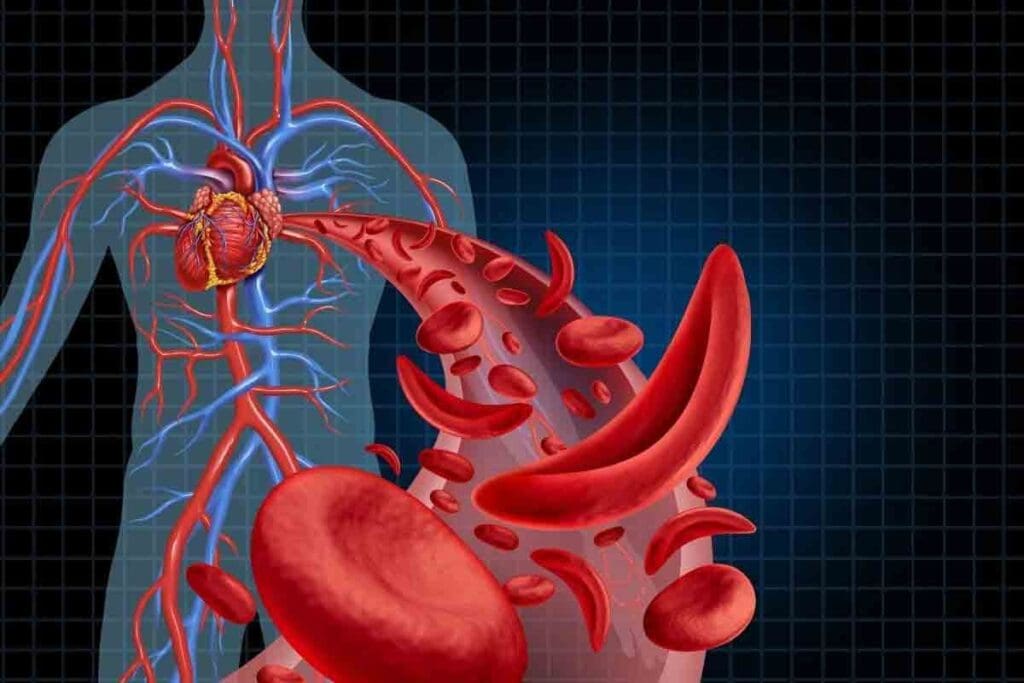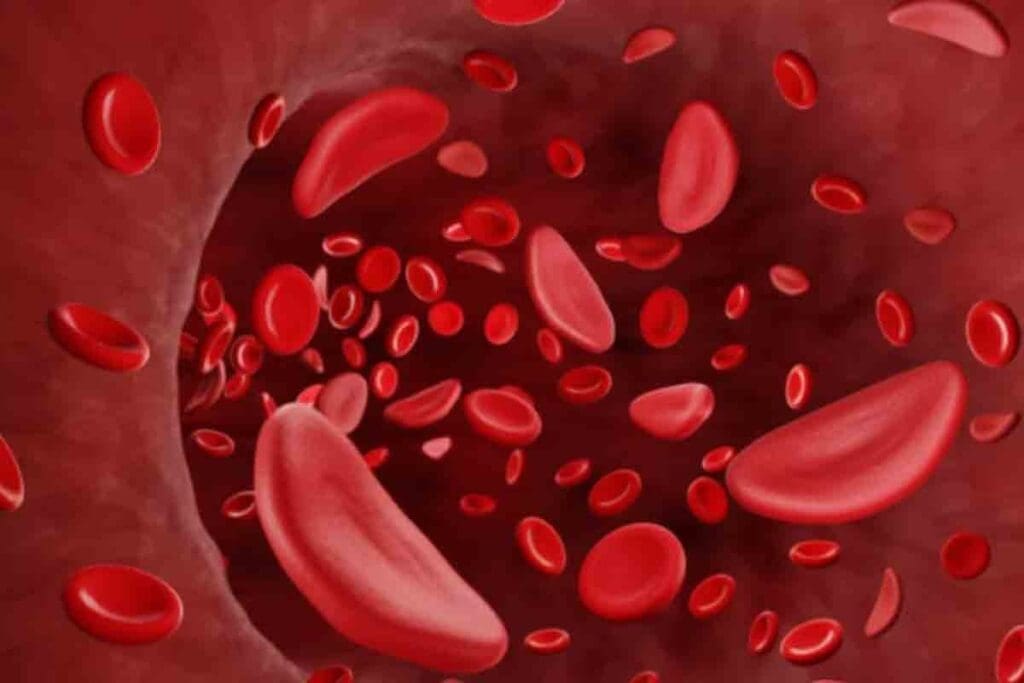Last Updated on November 20, 2025 by Ugurkan Demir

Sickle cell disease is not just for certain races. It can happen to anyone. At LivHospital, we know it’s not just for one race. People of all races, including Caucasians, can get it if both parents have the gene. Explore sickle cell disease in caucasians and racial differences in prevalence.
Sickle cell anemia is a blood disorder caused by gene mutations. It follows an autosomal recessive pattern. This means anyone can get it, no matter their race.
We will look into the genetics of sickle cell disease. We’ll talk about its demographics and racial differences. We’ll show it’s not just for certain groups.

It’s important to understand sickle cell disease to see how it affects people. This disease makes red blood cells not work rproperly It’s found in many groups, not just African Americans. For example, about 1.8 percent of sickle cell cases in the U.S. are in Whites.
Sickle cell disease makes red blood cells sickle. These sickled cells can block blood flow, causing pain and organ damage. The main problems are too much red blood cell breakdown and blood vessel blockage.
Symptoms include chronic pain, tiredness, and infections. Growth can also be delayed. The disease can lead to serious problems like organ damage and infections.
Here’s a summary of the key symptoms and complications:
| Symptoms | Complications |
| Chronic Pain | Increased Risk of Infections |
| Fatigue | Organ Damage |
| Frequent Infections | Acute Chest Syndrome |
| Delayed Growth | Stroke and Neurological Issues |
Knowing about these symptoms and complications helps manage the disease better. It improves life for everyone with sickle cell disease.

Sickle cell disease’s genetic pattern is key, not race. It’s inherited in an autosomal recessive way. This means a person needs two abnormal hemoglobin genes, one from each parent, to have the disease.
Sickle cell disease is autosomal recessive. If both parents carry the sickle cell trait, their child has a 25% chance of sickle cell anemia. This chance is the same for all ethnic groups, even though carrier rates differ.
To grasp this, let’s look at what happens when both parents are carriers. They can have a child with normal hemoglobin, sickle cell trait, or sickle cell disease.
| Genotype of Offspring | Phenotype of Offspring | Probability |
| Normal Hemoglobin | Normal | 25% |
| Sickle Cell Trait | Carrier | 50% |
| Sickle Cell Disease | Affected | 25% |
This table shows a 25% chance of sickle cell disease in each pregnancy if parents are carriers. This risk is the same for all races.
Sickle cell disease comes from a mutation in the HBB gene. This gene codes for a part of hemoglobin. If someone gets two mutated copies, they have sickle cell disease.
About 3 out of 1,000 white newborns in the US have the sickle cell trait. This shows the disease can happen in anyone, not just certain races.
Knowing the genetic cause of sickle cell disease is vital. It helps with genetic counseling and health decisions. The fact that the sickle cell trait is found in many groups stresses the need for screening and testing in all races.
Can white people get sickle cell disease? This question is about the genetic roots of the condition. Sickle cell disease is a genetic disorder that affects red blood cells. It’s caused by a mutation in the HBB gene and follows an autosomal recessive pattern.
This means a person needs two defective copies of the gene, one from each parent, to have the disease. While sickle cell disease is common in some groups, like those of African descent, it’s not only found in these groups. The genetic mutation can be found in people of many racial and ethnic backgrounds.
There have been cases of sickle cell disease in Caucasian populations, though they are rare. The disease can affect anyone with the mutated gene, no matter their race. In the U.S., for example, sickle cell trait, which shows one mutated gene, is found in diverse populations.
Seeing sickle cell disease in white individuals shows the need for genetic screening in all racial groups. Healthcare providers should consider sickle cell disease in their diagnosis, regardless of the patient’s race.
The chance of getting sickle cell disease is not tied to race. Anyone with parents who carry the mutated gene can be at risk. This makes genetic counseling and testing important for families with a history of the disease, no matter their ethnicity.
In conclusion, sickle cell disease is not exclusive to certain groups. White individuals can also get the disease if they inherit the mutated gene from both parents. Knowing the genetic basis and the possibility of the disease in all races can help in early diagnosis and better management.
Sickle cell disease is not just found in certain ethnic groups. It also occurs in Caucasians. Studies show it affects many racial and ethnic groups, but at different rates.
About 1.8 percent of sickle cell disease cases in U.S. hospitals are in Whites. This shows that, even though it’s less common in Caucasians, it’s a big health issue.
Research finds the sickle cell trait in white newborns at a rate of 3 per 1,000. This highlights the need for universal sickle cell disease screening, no matter the race or ethnicity.
A study looked at how sickle cell disease is studied in different races. It found SCD is mostly found in areas where malaria is common. This shows how genetics, geography, and disease are linked.
Also, research shows the sickle cell trait can protect against malaria. This could explain why it’s more common in malaria areas. This discovery helps us understand sickle cell disease worldwide.
To understand sickle cell disease, we must look at its history and where it comes from. This disease affects how red blood cells carry oxygen. It’s common in people from Africa, the Mediterranean, the Middle East, and South Asia.
The sickle cell gene started in places where malaria was common. The sickle cell trait helped protect against malaria, mainly the severe kind caused by Plasmodium falciparum. This protection made the sickle cell gene more common in these areas.
In these places, having the sickle cell trait helped people survive. Over time, this genetic adaptation made sickle cell disease more common in certain groups.
When people moved due to trade, slavery, or colonization, they took the sickle cell gene with them. This movement was key in spreading the gene around the world.
The transatlantic slave trade, for example, brought enslaved Africans to the Americas. This introduced the sickle cell gene to new areas. Migration within Africa and to other parts of the world also spread the disease.
Now, sickle cell disease is found in many places, not just where it first appeared. This shows we need to be aware and screen for it in diverse groups, not just those usually linked to it.
Knowing the history and origins of sickle cell disease helps us understand its spread. This knowledge is vital for creating effective health strategies and caring for those affected globally.
Studies show that the sickle cell trait helps protect against malaria. This is why it’s more common in some groups. It’s a big reason why the sickle cell trait has an evolutionary edge.
The sickle cell trait helps fight off Plasmodium falciparum malaria, a deadly malaria type. People with this trait often have fewer parasites and are less likely to get severe malaria.
We’ll look into how the sickle cell trait keeps malaria at bay. It seems to stop the parasite from taking over red blood cells.
The sickle cell trait is more common in places where malaria used to be big. This includes parts of sub-Saharan Africa, the Middle East, and India. These areas had a lot of malaria in the past.
| Region | Sickle Cell Trait Frequency | Malaria Endemicity |
| Sub-Saharan Africa | High | Historically High |
| Middle East | Moderate | Historically Present |
| India | Moderate to High | Historically High |
| Europe | Low | Historically Low |
This shows how the sickle cell trait has an edge in places with a lot of malaria. It’s been shaped by malaria, making it more common in these areas.
It’s important to know the racial demographics of sickle cell disease in the US. This knowledge helps in providing better healthcare. Sickle cell disease is not just common among African Americans. It affects many racial and ethnic groups.
The US population is getting more diverse. This is due to global migration and interracial marriages. So, the number of people with sickle cell anemia is changing.
About three per 10,000 people in the US have sickle cell disease. But the number varies a lot by race. Let’s look at the numbers:
| Race/Ethnicity | Prevalence Rate |
| African Americans | 1 in 400 |
| Hispanic Americans | 1 in 1,000 to 1 in 4,000 |
| Caucasian Americans | 1 in 10,000 |
This table shows how sickle cell disease affects different groups. It shows we need specific healthcare plans for each group.
The US is becoming more diverse. This is because of global migration and interracial marriages. Healthcare providers need to keep up with these changes.
Sickle cell disease is not just a problem for one race or ethnicity. By understanding these changes, we can offer fair healthcare to everyone with the disease.
The idea that sickle cell disease only affects African Americans is a harmful myth. It can cause people to miss out on early diagnosis. Sickle cell disease is not just a problem for African Americans. It can affect people from all racial and ethnic backgrounds.
We must see sickle cell disease as a global issue, not just a problem for one group. The myth that it only affects African Americans can lead to poor healthcare for others. This can cause delays in diagnosis for people who are not African American.
Many people think sickle cell disease only affects African Americans because it’s more common there. But it can happen to anyone, no matter their race or ethnicity. The disease is caused by a genetic mutation that can affect anyone.
A study in the Journal of Clinical Medicine found sickle cell disease in many different groups. This includes people from the Mediterranean, Mthe iddle East, and India. It shows we need to understand and talk about sickle cell disease more broadly.
| Population | Prevalence of SCD |
| African American | 1 in 365 |
| Hispanic/Latino | 1 in 16,300 |
| Caucasian | 1 in 40,000 |
The table shows that sickle cell disease is more common in African Americans. But it’s not just them. It’s also found in other groups, though less often. This means we should pay attention to it in all communities.
The myth that sickle cell disease only affects African Americans can cause delays in diagnosis for others. Doctors might not think of it for people who aren’t African American. This can lead to missed opportunities for early treatment.
“The racialization of sickle cell disease as a ‘Black’ disease can lead to a lack of awareness and understanding among healthcare providers, resulting in delayed diagnosis and inadequate care for patients from other racial backgrounds.”
-Hematologist
Delayed diagnosis can lead to serious problems. These include acute chest syndrome, stroke, and organ damage. Early treatment is key to managing sickle cell disease, no matter who you are.
To fight these myths, we need to spread awareness and education. We must teach healthcare providers and the public that sickle cell disease can affect anyone. This way, we can work towards better care for everyone, no matter their background.
Diagnosing sickle cell disease involves blood tests and genetic screening. These steps are important for everyone, no matter their race. Understanding these steps helps us catch the disease early.
Today, we use hemoglobin electrophoresis, complete blood count (CBC), and genetic testing to screen for sickle cell disease. These methods help find people with sickle cell trait and those with the disease.
Here’s a quick look at how we screen now:
| Screening Method | Description | Application |
| Hemoglobin Electrophoresis | Separates different types of hemoglobin in the blood | Diagnoses sickle cell disease and trait |
| Complete Blood Count (CBC) | Measures various components of blood, including red blood cell count | Helps identify anemia and other blood disorders |
| Genetic Testing | Analyzes DNA to identify genetic mutations causing sickle cell disease | Confirms diagnosis and identifies carriers |
To get better at diagnosing, we need to screen everyone, not just certain groups. This way, we catch sickle cell disease in all people, not just some. It helps avoid late diagnoses.
By raising awareness and starting wide-screening programs, we can better find and manage sickle cell disease. This is key to giving the right care to those who need it.
Managing sickle cell disease needs a detailed treatment plan for each patient. The disease affects people from many racial and ethnic groups. Yet, the treatments are mostly the same for everyone.
The main treatments for sickle cell disease include several options. Hydroxyurea therapy helps lessen painful crises and may cut down on blood transfusions. Blood transfusions are also key, as they lower the risk of serious problems by reducing sickled red blood cells.
Pain management strategies are vital for dealing with the disease’s pain. In some cases, bone marrow transplants might be an option, aiming for a cure but with risks.
| Treatment Modality | Purpose | Benefits |
| Hydroxyurea Therapy | Reduce frequency of painful crises | Decreases the need for blood transfusions, improves the quality of life |
| Blood Transfusions | Reduce risk of complications | Decreasesthe number of red blood cells that can sickle,improvings oxygen delive.ry |
| Pain Management | Manage acute and chronic pain | Improves quality of life, reduces hospitalizations |
| Bone Marrow Transplant | Potential cure for sickle cell disease | Can eliminate disease, but carries significant risks |
Even with these treatments, care disparities exist. People fromlower-incomee backgrounds and those in areas with poor healthcare face big challenges. They often struggle to get the care they need.
We need to address these disparities. We must ensure everyone with sickle cell disease gets fair healthcare, no matter their race or income.
Understanding sickle cell disease is more than just looking at racial categories. It affects people from all walks of life, including Caucasians, but in different ways.
The demographics of sickle cell disease are complex. They are shaped by genetics and history. It’s important to remember that sickle cell disease isn’t limited to one race.
At LivHospital, we aim to offer top-notch healthcare. We follow strict academic standards and keep our care up to date for everyone. We know that sickle cell disease affects Caucasians too, and they need proper care.
Good care for sickle cell disease means understanding its genetics and demographics well. By seeing the disease’s diverse impact, we can offer better care to all patients. This care should be fair and complete, no matter their race.
Yes, white people can get sickle cell disease. It’s more common in certain racial and ethnic groups. These include people of African, Mediterranean, Middle Eastern, and South Asian descent.
Sickle cell disease is a genetic disorder. It’s caused by a mutation in the HBB gene. This leads to abnormal hemoglobin and sickling of red blood cells.
No, sickle cell disease is not exclusive to specific racial or ethnic groups. It can affect anyone who inherits two copies of the mutated gene, regardless of race.
Sickle cell disease is less common in Caucasians. It’s found in about 1.8% of hospitalized cases. The sickle cell trait is present in about 3 per 1,000 white newborns.
Sickle cell disease is caused by a mutation in the HBB gene. This gene codes for the beta-globin subunit of hemoglobin. It’s inherited in an autosomal recessive pattern.
Yes, people of any race can inherit sickle cell disease. This happens if they get two copies of the mutated gene, one from each parent.
The sickle cell trait offers some protection against malaria. The mutated hemoglobin makes it harder for the malaria parasite to infect red blood cells.
Yes, there are disparities in healthcare access for sickle cell disease patients. These disparities exist across different demographics. This highlights the need for equitable care.
Standard treatments for sickle cell disease include hydroxyurea therapy and blood transfusions. These treatments aim to manage symptoms and prevent complications.
Universal screening for sickle cell disease is key. It helps identify individuals with the disease or trait, regardless of race. This ensures timely diagnosis and care.
Subscribe to our e-newsletter to stay informed about the latest innovations in the world of health and exclusive offers!